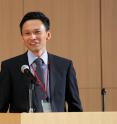Bossy cock takes the lead vocal of cock-a-doodle-do
Related images
(click to enlarge)
From ancient times, people have been aware of the rooster's "cock-a-doodle-do" that marks the break of dawn, but has anyone wondered who crows first? In a new study published in Scientific Reports, ITbM's biologists have revealed that there is actually a systematic rule based on social ranking that determines the order of crowing in roosters. Nagoya, Japan - Since the period of the Indus Valley Civilization (around B.C. 2600-1800), the rooster's "cock-a-doodle-do" has been used to announce the time and most people now know that roosters crow in the morning. Nonetheless, the mechanism underlying this phenomenon has been a long-term mystery. In 2013, Tsuyoshi Shimmura and Takashi Yoshimura of Nagoya University have reported in Current Biology that the rooster's crowing mechanism is actually governed by their internal biological clock.
Triggered by the first crow from a rooster, other roosters nearby also start to crow like a ripple effect. Crowing is considered to be an action by roosters to alert others of their territory. In addition, chickens are known to be highly social creatures and develop a dominance hierarchy called pecking order when a small number of chickens forms a group. This pecking order starts with the dominant chicken pecking all the chickens, the second dominant chicken pecking all the chickens apart from the dominant chicken and with the least dominant chicken remaining harmless.
The social ranking of roosters is strongly reflected in the actions within the groups, and the highest ranking rooster has been known to have priority in eating and mating. Published online in Scientific Reports, Shimmura and Yoshimura discovered for the first time that the order of precedence of crowing in roosters is also based on social ranking within the group.
Through observation of a group of 4 roosters, Shimmura in Yoshimura's research group, currently an assistant professor in the National Institute of Basic Biology in Japan, found that there was a systematic rule in the order of crowing. Further investigations revealed that the highest ranking rooster among the group was always the first one to crow in the morning. The crowing was followed by the second, third and fourth ranking roosters, which shows that roosters crow in descending order of their social ranking.
In addition, the starting time to crow for the most dominant rooster varied from day to day, but the crowing of the lower ranking roosters always started right after the crowing of the highest ranking rooster. From these observations, Shimmura and Yoshimura identified that the most dominant rooster had priority to announce the break of dawn by being able to determine the timing to crow within the group. Upon removing the highest ranking rooster from the group, the second ranking rooster became the first to crow, showing that the second ranking rooster can also take the role of the most dominant rooster.
Along with these results, they also showed that the frequency of voluntary crowing was lower for subordinate roosters compared to dominant roosters. On the other hand, upon stimulating the roosters to crow using light and/or sounds, they found that the subordinate roosters crowed as much as the dominant roosters. This indicates that although the subordinate roosters have the ability to crow, they have the patience to wait every morning for the most dominant rooster to crow before crowing themselves.
"We have discovered that roosters live in a strictly linear hierarchy, where social ranking reflects the order to announce the break of dawn," says Yoshimura, who led the research and is a principal investigator at the Institute of Transformative Bio-Molecules (ITbM) in Nagoya University.
Source: Institute of Transformative Bio-Molecules (ITbM), Nagoya University
Other sources
- Social pecking order gives roosters something to crow aboutfrom Sciencenews.orgFri, 24 Jul 2015, 20:50:19 UTC
- Which dawn-announcing rooster crows first?from UPIFri, 24 Jul 2015, 15:20:26 UTC
- Bossy rooster takes lead vocal of cock-a-doodle-dofrom Science DailyFri, 24 Jul 2015, 14:20:27 UTC
- Top cock: Roosters crow in pecking orderfrom PhysorgThu, 23 Jul 2015, 15:40:11 UTC

